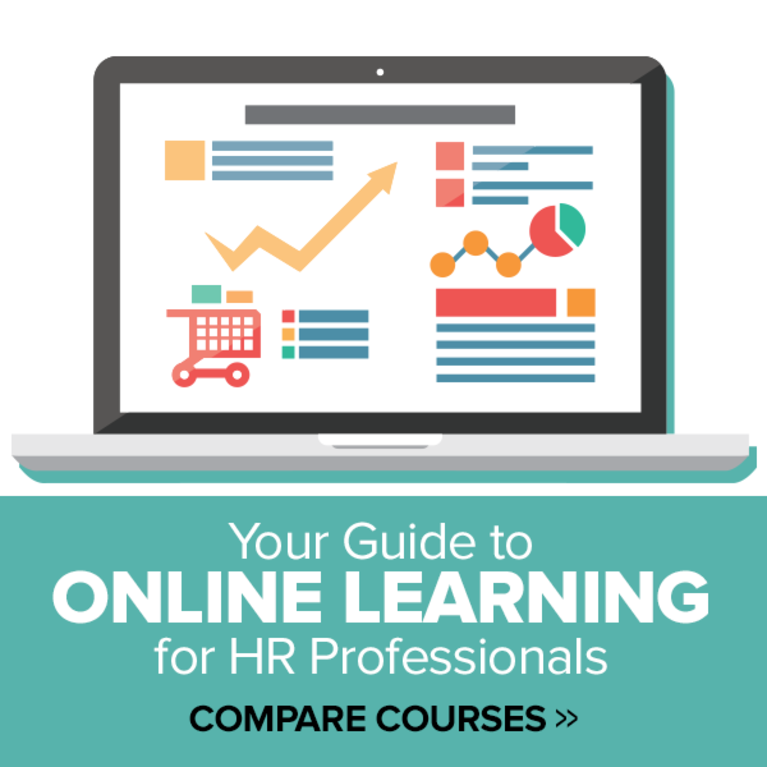Online Learning for HR
With a wealth of HR and business courses available online, selecting the right one is critical.
Introduction
When massive open online courses—better known as MOOCs—first came on the educational scene, nobody knew whether they would be the next big thing in learning or just another quirky acronym. MOOCs are Web-based classes that are available to all, and they’re often free. Today, along with MOOCs, other online learning programs have become common, and HR professionals are using all of them to develop new skills and advance their careers.

The growth of online learning has been rapid. For instance, since MOOCs became popular around 2011, 35 million students have given them a try, says Dhawal Shah, head of Class Central, a San Francisco-area organization that tracks MOOCs and curates reviews of them. More than 17 million people registered for MOOCs last year alone. Many are designed by higher education institutions, including the likes of Harvard and Stanford. Business classes, including HR courses, made up about 17 percent of the offerings in 2015. The courses are distributed through digital platforms built for learning. Coursera, edX, FutureLearn and Udacity, for instance, offer programs from a variety of colleges.
Students are attracted to online education in part because of the convenience. “The promise of MOOCs is easy access to learning. I can do this in 10 minutes on the subway or 20 minutes in the morning waiting for my kids to get up,” says Fiona Hollands, associate director in New York City of the Center for Benefit-Cost Studies of Education at the Teachers College, Columbia University.
Julia Stiglitz, director of business and market development at Mountain View, Calif.-based Coursera, listens to MOOC lectures as she drives. “All of our jobs are changing so quickly. All of us are looking for tools and resources that will allow us to stay up to date,” she says.
There is a dizzying array of free classes, as well as certificate programs and college degrees, available online for HR professionals eager to advance their knowledge and careers. The trick is selecting the right one.
Unlike most MOOCs, online degree programs in HR require tuition payments and admission into the school. More than 5 million students currently are taking college credit classes online, according to the Babson Survey Research Group. Free noncredit HR courses are also common.
payments and admission into the school. More than 5 million students currently are taking college credit classes online, according to the Babson Survey Research Group. Free noncredit HR courses are also common.
Somewhere between the college credit classes and the no-cost sessions are certificate programs that come with a fairly modest price tag and provide students with a professional certificate or training toward credentials, such as a SHRM-CP or SHRM-SCP.
These online programs can help HR professionals develop specific expertise in such specialties as compensation, benefits, talent acquisition and employee relations, or they can aid in the development of broader business skills in such competencies as critical evaluation, relationship management and communication.
HR plays an important role in improving the bottom line for organizations, says Sam Sanders, SHRM-SCP, director of academic affairs for the Atlanta campus of the University of Phoenix. “Because of that, it’s important for HR professionals to be on the top of their game.”
But choosing the right learning option can be complicated in the decentralized world of online learning. Fortunately, there are resources available to help. Websites such as Class Central and MOOC List contain useful information about online courses. Coursera has the largest lineup of MOOCs—about half of all available classes—although individual colleges and other organizations also offer their own.
“It’s kind of a Wild West of MOOCs. They are all independently developed and directed,” says Leah Matthews, executive director of the Distance Education Accrediting Commission in Washington, D.C.
Considerations
Before choosing an online program, here are some issues to consider:
Credibility. Is the provider well-regarded? Of course, Ivy League universities have great reputations, but lesser-known schools can design effective programs as well. And some companies, associations and nonprofits also have strong offerings. Consult with professionals in your field whom you respect for their feedback on a specific program you’re considering. For business school courses, the Association to Advance Collegiate Schools of Business (AACSB) could serve as a guide. It doesn’t accredit online classes, but it does give its stamp of approval to b-schools that offer Web-based learning.
Course design. Many online programs provide a syllabus or video of the teacher talking about the work that will be required. If you can’t raise your hand and ask the professor to explain something online, you need to make sure the lessons are explained well. “I’ve opened the page to some [online class materials] and I can’t figure out what to do and I’m an academic,” Hollands says.
Time commitment. Only about 5 percent of students who start a MOOC ever finish it. Many courses last 5 to 10 weeks. Keep in mind that the shorter the class is, the more likely you may be to complete it.
More than 5 million students currently are taking college credit classes online, according to the Babson Survey Research Group.
Learning style. MOOCs are a bad choice for people who are not self-motivated. Some have discussion boards that can help people who need to engage with others, but keep in mind that a forum with thousands of posts may be less valuable than one with separate smaller threads. Often, the value of an online discussion depends on the knowledge of other students and the instructor. The experience and background of the other enrollees is also important when there is a discussion component, Hollands says. For example, in an HR-related session, you’ll likely get the richest interaction if most participants are other HR professionals. Prerequisites and course descriptions can be clues to who else will be enrolled.
Class size. How many students are taking the course? That will affect how much attention you’ll get from the instructor and how interactive the class is likely to be. University online degree programs often set limits at 30 or fewer students so that enrollees get attention from the teacher and are able to hear the perspectives of other participants. For MOOCs, the average class size is 40,000. Courses without a cap on enrollment might not have enough support services to help students. Look for tutoring options and other learning support in the descriptions of the programs.
Content. Does the course material lend itself to your learning needs? A global MOOC, for instance, might not help HR practitioners who need to increase their knowledge about state laws. And a one-way online learning module may not be the best way to develop interpersonal skills, such as how to have conversations with difficult employees.
Student reviews. Before you sign up for a class, take a look at what other students have to say about it. In addition to reading online reviews, go old-school and ask people you know about their experiences.
Pace of learning. Will you be working at your own pace, or does the course have a set start and end date? If it’s the latter, you’re more likely to benefit from a cohort of students learning together.
Built-in Advantages …
Many MOOCs and other online courses offer some natural advantages, including low costs, a flexible educational experience and the opportunity to learn from the world’s greatest teachers.
Technology is another plus. Data analytics used by the providers, for instance, can help teachers identify topics that students may be struggling to understand. If the statistics show that 35 percent of the students had to rewind an instructional video at a certain point, the teacher can clear up any confusion when addressing the class. And videos with pop-up quizzes can engage students more effectively than if those individuals were sitting in a vast lecture hall fighting to stay awake.
Advances in technology have led to more-interactive MOOCs that offer better student experiences, says Dan LeClair, executive vice president and COO of the AACSB in Tampa, Fla. Many courses provide a chance for students from all over the world to interact on discussion boards.
… And Inherent Drawbacks
Despite their considerable promise, there are some downsides to MOOCs, including the extremely high dropout rates. Coursera’s dropout rate, like that of MOOCs in general, is about 95 percent. But many of the dropouts are people who were auditing the class or just clicking a few buttons to enroll and learn more about it, according to Stiglitz. Of the company’s students who pay the $49 to $79 to receive a certificate proving they have completed a program, about 70 percent finish.
“We want people to learn and master the information. It requires work. It’s not as simple as watching a video,” Stiglitz says.
Employers are still sorting out whether MOOCs and other programs should count toward advancement and raises and factor into hiring, although many value online learning. Certificates are often listed at the top of LinkedIn resumes, and a Coursera survey of 52,000 students found that one-third said the course they took translated into a tangible benefit, such as a new job, promotion or raise.
Companies are often wary about giving workers credit for completing online courses because of the possibility that the employee had someone else do the work. Another loophole involves setting up two accounts to take the same class. By completing assignments and tests with the first account, a student can get the correct answers and submit them as part of the second account, which is then used to get credit toward a certificate.
“The cheating issue is a significant problem,” Hollands says. But there are also risks of underhanded behavior with face-to-face learning.
To combat dishonesty, providers offering certificates can use webcams to verify that the correct student is doing the work or can use software that recognizes a person’s typing patterns as if they were a digital fingerprint. At the Boston-based MOOC platform edX, which was started by Harvard and MIT, every student signs an honor code, says Rachel Lapal, senior manager of communications. Some classes also make cheating harder by using randomized problem sets so not all students get asked the same questions.
Continuing Evolution
HR professionals need to think about how to assess online courses, both for their own development and for the people they hire and train.
There are signs that companies are increasingly valuing online learning. “Employers are starting to look at [virtual education] to see if people have skills for the job,” Lapal says. “It’s a stamp of approval if you can show you’ve done something from beginning to end.
Another perk for HR professionals: Taking online classes helps you better understand how the format works when you design educational programs for your organization.
Many of the experts involved in MOOCs and other online courses are watching to see how the HR community reacts to them. There is no course that is going to deliver 100 percent of what people want and need. “But they’re going to learn something,” says Donald Burnell, an HR course instructor for a UCLA-affiliated program. “This is a new game and a new way to experience education.”
Tamara Lytle is a freelance writer in the Washington, D.C., area.
Opening illustration by Lorelyn Medina.


